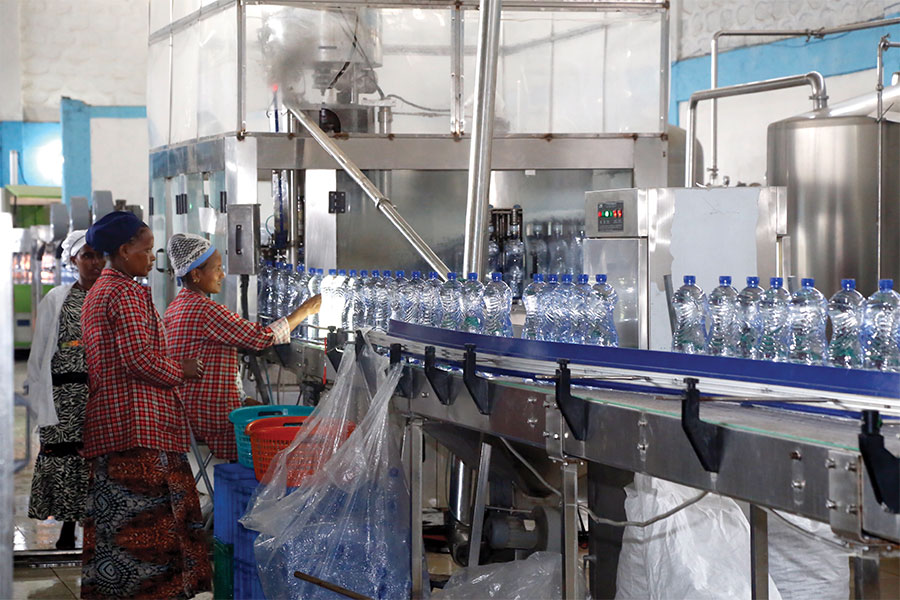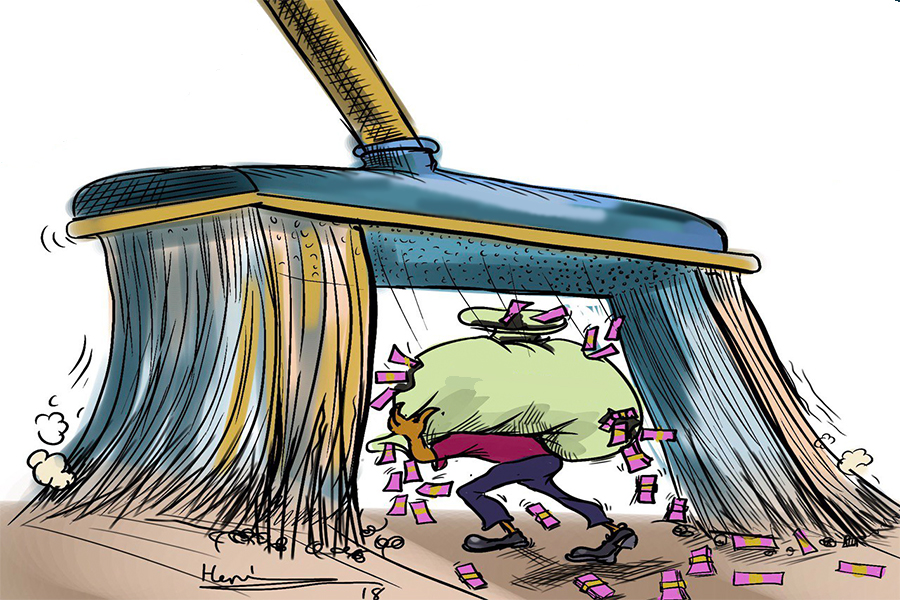
Fortune News | Apr 02,2022
On windy weather a fortnight ago, an unprecedented loud noise came into effect as a segment of scaffolding nearly six meters high collapsed on one of the suburban houses around Derartu Roundabout a.k.a Ayat Mazoria.
The woods erected on a construction skeleton that was left idle for a year plunged into the house that was occupied at the time.
"It could have killed us," said the frustrated home-owner Natnael Getachew.
He claims the officials from Lemi Kura district inspected the accident and suggested dealing with it cordially. While their roof was fixed over the weeks, Natnael is disappointed that no measures were taken for endangering their lives.
Lemi Kura district is home to 10 woredas where over 100 construction projects are underway.
The Administration obliges contractors to incorporate safety in their architectural design, comprising structure, sanitation and electric plans when applying for permits at building permission and controlling office.
Contractors then sign an agreement with neighbouring houses to comply with boundaries, privacy and safety measures. The mandate to monitor fall on the administration which oversees every phase of construction goes according to plan maintaining the quality standards.
Elias Teshome, an architectural design permit expert, said the inconsistent timelines of projects have made it difficult to constantly oversee whether construction sites are meeting the standards or not. The reluctance to declare every phase of the project by contractors has exacerbated the problem, according to Elias.
When the 46-year-old Natnael moved to the residential area eight years ago, he hoped to get a break from the hustle and bustle of city life despite the long commute. However, since the eight-storey building construction started next door three years ago, frequent banter of materials has been pestering their peace.
"We couldn't rest in our own house," he said.
The construction hazard Natnael and his family faced is one of many incidents on construction sites. Projects that most often necessitate deep excavation and high-rise finishing ultimately expose estimated one million workers in the capital to stand face-to-face with the risk.
About a fifth of the nearly two million occupational fatalities and a tenth of injuries worldwide are accounted to the construction industry, according to data from the International Labour Organisation.
Surveys conducted in several parts of the country suggest that close to 40pc construction workers suffer occupational injuries. Last year, about 24 workers lost their lives at construction sites in Addis Abeba while 50 workers faced severe injuries, according to data from Addis Abeba Construction Permit & Control Authority.
On the road from Meskel Square to the Olympia area where sky-rocketing construction projects are filling the city's landscape, nearly a dozen men are carving metal in the basement of a three-storey building.
Among them is Gemechis Terefe, 26, who came from Adama (Nazareth) town looking for an opportunity to make a living. Working as a steel operator for over seven years, he has perceived the non-existence of safety equipment provided.
Gemechis has observed many workers undergoing severe injuries with little to no attention given to their misfortunes.
He sustained multiple minor injuries from stepping on metals to itchy eyes from welding metals without glasses. But he said that workers who insisted on the provision of appropriate safety gear were left idle.
"I had no choice but to get used to it," he said.
Unionization has created a lifeline for workers to be provided with safety equipment and for employers to take workers' safety seriously.
Zegeye Haileselassie, president of the Ethiopian Federation of Construction observes that occupational health and safety seem non-existent affair in projects undertaken by local contractors.
His Federation represents over 45,000 construction workers under 140 trade unions. The lean inclination of employees and workers to comply with standard safety procedures has exacerbated the problem.
"Safety deserves more attention," he said.
While employers avoid getting insured for fear of cutting through their budget, the apprehension of abusing the benefit with pre-meditated injuries was cited as a reason by some.
Abebe Girmay Building Contractor, a grade-one construction company, has worked on over 30 state-owned projects since its establishment in 2005. The Company started issuing safety equipment ten years ago for its 120 permanent workers.
The Manager Abebe disclosed the rising inflation has delved deep into contractors' budgets making it hard to buy equipment while the reluctance of workers to wear their safety equipment has become extensive.
The revised version of the Ethiopian Building Code of Standards has been updated to include health and safety standards in building construction works since 2014.
Officials cite the unpredictable project timelines plagued with the skyrocketing price of construction materials as an impending issue for failing to perform scheduled regulations.
Over 20,000 permits were issued in the fiscal year by the Addis Abeba Construction Permit & Control Authority. According to Sitotaw Akale, head of the Authority, measures were taken on 1,000 contractors for tampering with the design plans, commencing construction without supervision, and lagging in equipping workers with safety materials.
He disclosed the vast projects in the city with uncertain schedules have made it challenging to pursue timely checkups.
"We're doing our best," he said.
Ethiopian Construction Authority under the Ministry of Urban & Infrastructure, put forth over 1,000 building codes and standards over the past years where 14 were compulsatory. It is tasked to oversee close to 200 public projects in the fiscal year.
Abebe Banjaw, building regulation director at the Authority, said that the plummeting quality of construction inputs coupled with untrained workmanship are damaging the sector while reconstruction costs, injuries and loss of life due to structural collapse were observed.
"Over 70pc construction projects are handled sub-optimally," he said.
According to Abebe, loose scaffolding is becoming a risk to workers and pedestrians, where steel should have been used for buildings above four storeys. Even though construction accidents occur frequently, he disclosed that the lack of available data makes follow-ups difficult.
"Information is usually withheld," he said.
The nature of the job and demanding requirements have made formulating legal frameworks pivotal while the Ministry of Labor & Skills is the state organ entrusted with following up on workers’ safety and health issues.
According to Tiumezgi Berhe, safety health and labour inspection head at the Ministry, helmets and reflective jackets are rendered as accessories to be worn by casual visitors while the focus is mainly put on the work rather than the process.
He said the Ministry is creating awareness for every stakeholder to comply with the ideals of construction.
"We'll begin taking legal measures on those who don't comply," he said.
Only 2,120 construction companies have insurance policies for their employees, accounting for less than seven per cent of the total insurance claims. The amount is meagre considering the number of construction injuries and construction projects in the country, according to Zufan Abebe, president of Nib Insurance S.C.
She indicated that construction premiums fall under the biggest rates calculated with the number of employees and their exposure to danger ranging from 0.8 to 1.5pc. She said contractors often withhold some of their employees when registering for insurance policies to avoid exacerbated annual premiums.
"It's often a source of dispute," she said.
The Ministry of Urban & Infrastructure is preparing legal frameworks and construction auditing with legal experts drafting a proclamation, a policy and regulation to address concerns about occupational safety.
"It'll bridge the huge gap," said Medina Ahmed, lead executive of construction & infrastructure at the Ministry.
Medina observes that enforceability of the rules and regulations and awareness of each stakeholder remains an impeding gap where measures are taken after irreparable accidents have incurred.
Experts believe the lack of efficacy and understanding of contractors and consultants should be mitigated through continuous training stressing the importance of awareness of workplace hazards and enforceable legislative frameworks.
"There needs to be a stringent shift in the construction industry," said Abebe Dinku (Prof), a civil engineer for more than three decades with several publications under his name.
Abebe suggests factoring adequate safety and health standards into bid selection processes to wipe out those who perceive safety and health requirements as unnecessary and cost-incurring practices. Meanwhile, he said strict legal enforcement should be underway to uphold accountability.
PUBLISHED ON
Aug 19,2023 [ VOL
24 , NO
1216]

Dec 22 , 2024 . By TIZITA SHEWAFERAW
Charged with transforming colossal state-owned enterprises into modern and competitiv...

Aug 18 , 2024 . By AKSAH ITALO
Although predictable Yonas Zerihun's job in the ride-hailing service is not immune to...

Jul 28 , 2024 . By TIZITA SHEWAFERAW
Unhabitual, perhaps too many, Samuel Gebreyohannes, 38, used to occasionally enjoy a couple of beers at breakfast. However, he recently swit...

Jul 13 , 2024 . By AKSAH ITALO
Investors who rely on tractors, trucks, and field vehicles for commuting, transporting commodities, and f...

Oct 25 , 2025
The regulatory machinery is on overdrive. In only two years, no fewer than 35 new pro...

Oct 18 , 2025
The political establishment, notably the ruling party and its top brass, has become p...

Oct 11 , 2025
Ladislas Farago, a roving Associated Press (AP) correspondent, arrived in Ethiopia in...

Oct 4 , 2025
Eyob Tekalegn (PhD) had been in the Governor's chair for only weeks when, on Septembe...